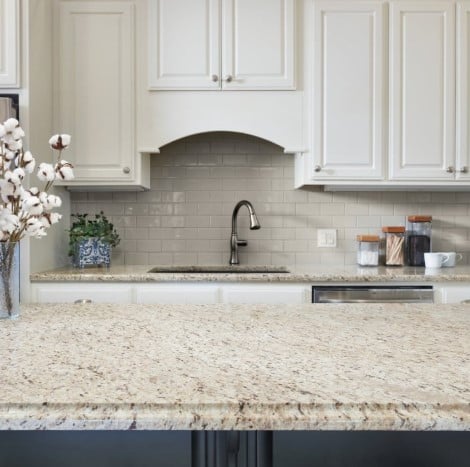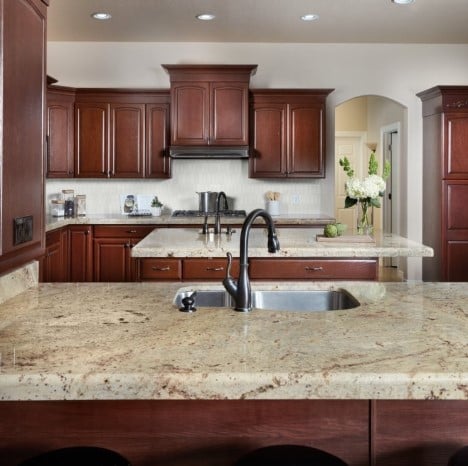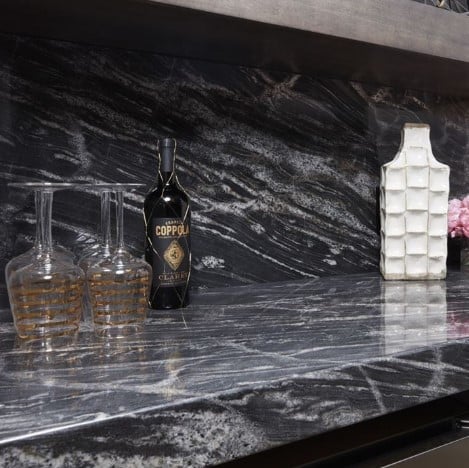
Granite is one of the most popular varieties of natural stone and an excellent, durable choice for countertops. As you peruse all the options when it comes to using granite for your next home project, you may be wondering what granite is made of. Let’s dive into this well-known and well-loved stone to find out more about where granite is from, what it’s made of and why it looks the way it does.
What minerals are in granite?
A type of igneous rock, granite is formed under the earth’s surface by magma that slowly cools and crystallizes over time. It is composed of a variety of different minerals that lend various characteristics, colors and patterns to the final product. Minerals usually found in granite include:
- Quartz. The common mineral quartz gives granite its density and hardness, usually with a white to gray color. Quartz is also found in other dense natural stones such as quartzite.

- Feldspar. Generally opaque white, pink, beige or brown, feldspar is another major component of granite. Crystals of feldspar in the surface of a granite slab tend to have a large, blocky appearance. In some instances, labradorite (a mineral in the feldspar family) can give granite a blue tone.
- Mica. Many varieties of granite also contain a small amount of mica minerals—but a little goes a long way. Flakes of mica within the stone give it a reflective quality that sparkles and shines. There are two types of mica in granite that can give distinctive looks: muscovite is clear or silver colored, while biotite is black.

- Hornblende. You probably haven’t heard of this mineral, but hornblende is another constituent of many granites. Grains of hornblende in granite are black, dark green or brown in color.
While there are a multitude of other minerals that can be found in granite to create different colors, these are the most common. Together, they create the characteristic granular, crystalline texture and look that granite is known for. The beauty of natural stone is that every slab is one-of-a-kind. Some varieties are fairly consistent but others may have visible differences in color, veining or movement from slab to slab.
How is granite mined?
Granite is one of the most common types of bedrock stone found on Earth. It is currently mined in a range of large quarries throughout India, the US, China, Brazil, Canada and other countries.
The process of mining granite begins with powerful machines and synthetic diamond used to carve out granite blocks from the quarry. These blocks are then transported to granite mills, where they are cut into slabs about 9-10 feet in length. Slabs are then polished before being sent to slab yards and warehouses. When you purchase a granite slab, the final step is fabrication, where your chosen slab is cut to fit your countertop.
Where can granite be used in the home?
Granite’s density and durability make it a good choice for high-traffic countertops in the kitchen or bathroom. It’s fairly resistant to scratching and chipping due to its composition, and if properly sealed it will not stain. However, as with any natural stone we still recommend you protect your granite surfaces as well as possible. Use trivets under pans to avoid exposing granite to excessive heat, and clean up any spills right away so you can continue to enjoy your beautiful granite countertops for many years.
Hear what Yelper Linda P. of Tucson, Arizona had to say about our granite selection at our Tucson location:
Arizona Tile, Tucson has a great showroom and stellar consultants who have allowed us to envision our dream home! Their tile and granite selections are truly amazing and have allowed us to coordinate tiles, granite and borders that complement one another…a characteristic that other stores we visited did not come close to providing.
Want to see what granite would look like in your home? Check out our Just Imagine Visualizer.





